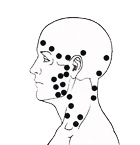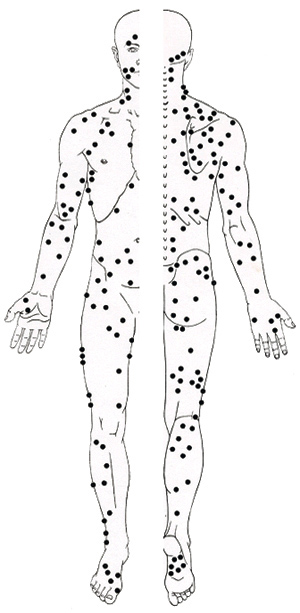Trigger Points
TRIGGER POINTS DEVELOP AS A RESULT of muscular injuries, strains and trauma. Additionally, structural imbalances, improper body mechanics, poor nutrition and mental or emotional stress are all factors. When muscle fibers, fascia, ligaments or tendons become weakened, overstretched or inflamed, tiny tears in the associated soft tissue can occur. As the tissue heals it contracts, becoming twisted and knotted. These knotted fibers restrict the fresh blood supply needed by the muscle cells. In addition there is often a shortening of the muscle fiber to protect itself from further injury. In effect, the muscle learns to avoid pain and guards against it by limiting its movement. This results in a loss of range of motion of the joint and the probability that the muscle and associated structures will develop trigger points.
Skeletal muscle, the largest single organ of the human body accounts for 40% or more of body weight. As reported there are 200 paired muscles, a total of 400 muscles, any one of which can develop myofascial trigger points. The circles on the outline of the body form represent points located on the side of the body.
ACUTE PAIN RESULTS FROM ONE TIME sudden physical trauma including; auto accidents (whiplash), falls, improper lifting, sudden twisting or turning movements and excessive or unusual exercise. These types of injuries if minor, will usually resolve themselves with a few days rest and avoidance of further aggravation. Once the injuries have healed, stretching and strengthening exercises are necessary to recondition and restore the strength and flexibility of the injured muscle or joint. The associated trigger point(s) must also be inactivated once the injury has healed. If not treated effectively, a cycle of increasing pain, muscle spasm and loss of function can occur and develop into a chronic condition.
TRIGGER POINTS ARE FOUND WITHIN a hard, ropelike or knotted band of muscle. You will know when you have found one as it will be very sensitive to the touch. By sensing this tenderness you are given an opportunity to become aware of it and to consider it’s cause. Muscles involved in past surgeries tend to have painful trigger points as do muscles located around the joints. Some points, particularly those between the shoulder blades will be instinctively located, while others may require a bit of detective work on your part. Gentle stretching of your muscles on a regular basis will provide you with the clues needed to help you help yourself. Make the necessary commitment to personal wellness today. Most muscles and trigger points are paired. A point on the right side of your body has a corresponding point on the left side. Normally the most tender of these parallel points or muscles will be on the same side that’s painful. Pressure applied to this side will usually give the most relief. For best results, however, pay equal attention to points on both sides of your body.
CHRONIC PAIN RESULTS FROM PAST injuries and from numerous, uncorrected and underlying causes. Usually it is the initial trauma that initiates trigger point activity in a muscle, while other factors work together to prolong it. Poor sitting and standing posture, nutritional inadequacies (often vitamin B1, B6 and B12), postural and mechanical stress allow pain to continue for months and even years. The description of chronic pain is unique to each individual and may be described as burning, throbbing, stabbing, deep, dull and achy with varying intensities of discomfort. Treatment by your medical practitioner will be necessary to help unravel chronic cycles of pain.
Body form outline reprinted with permission of Williams & Wilkins.
Copyright © 1995-2010, Thera Cane Co.
www.theracane.com
U.S. Patent #D317,204


